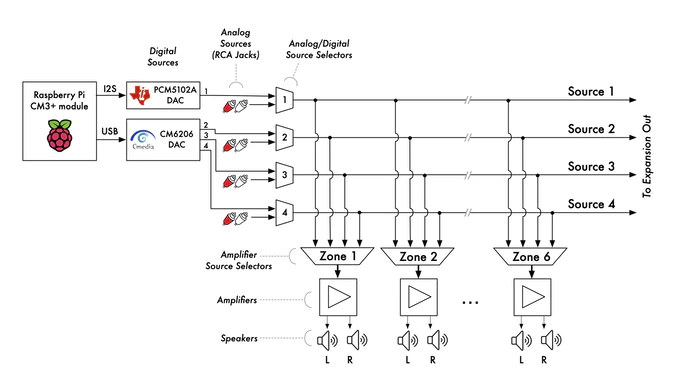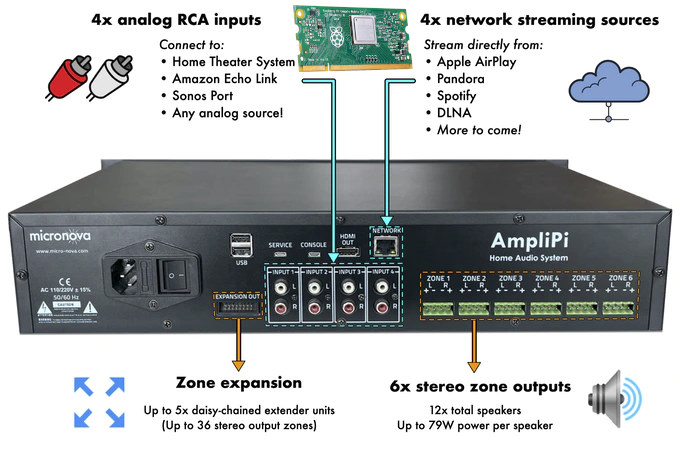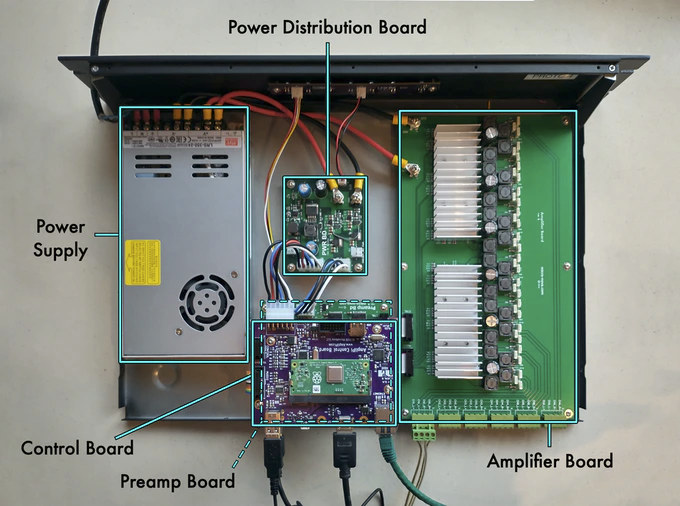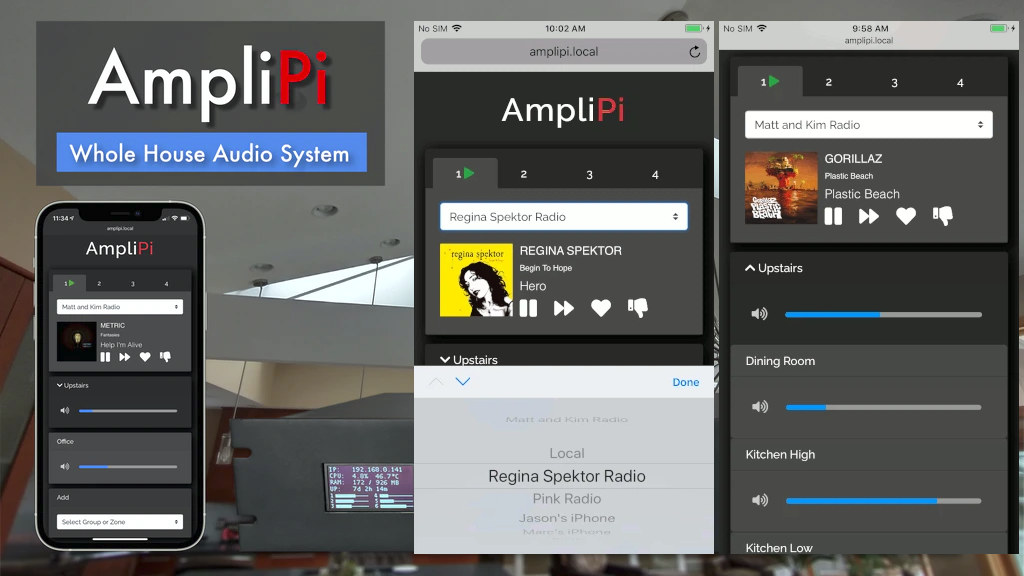Micro Nova has put together an open-source, whole-house audio amplifier called AmpliPi based on Raspberry Pi Compute Module 3+. It is capable of streaming four independent sources to 6 stereo output zones, expandable to up to 36 stereo output zones through daisy-chained extender units.
AmpliPi specifically supports inputs from four networking streaming sources including AirPlay, Pandora, Spotify, and DLNA, as well as four analog RCA inputs for your media appliances.
AmpliPi key components and features:
- Controller Board
- Carrier board fitted with Raspberry Pi Compute Module 3+ and PCM5102A & CM6206 audio DACs. It also communicates over I2C with the STM32 MCU on the Preamp board (see below) to control the muxing and amplification systems.
- Interfaces
- 10/100M Ethernet port
- HDMI 1.4 output
- 2x USB 2.0 ports, plus one internal USB port
- Service and console ports for maintenance and/or debugging.
- Preamp Board
- Board equipped with a 6×4 audio matrix switching system and volume control network that is managed by an STM32F030 Arm microcontroller that also controls the mute and power settings for the amplifiers. The matrix switching system can also allow the user to mix multiple inputs on one or more outputs
- Connector
- 8x RCA inputs for 4x stereo sources
- Zone expansion connector
- Amplifier Board
- This board contains the 6 stereo class-D PWM amplifiers required by the 6 speakers. Class-D PWM amplifiers enable a more efficient system and reduce the need for cooling fans which are activated less often.
- 6x 4-pin speaker connectors
- Small display configured to show the IP address, system utilization, and volume levels by default.
- Mean Well switching power supply and power distribution board.
- Power Consumption – 6.7W in standby mode, up to 391W continuous, up to 782W peak
- Dimensions – 2U 19-inch rackmount system with 300mm depth

The Raspberry Pi module runs Raspberry Pi OS with Web App server, streaming music clients (Pandora, AirPlay, Spotify, etc), and custom software for the REST API interface.
The amplifier can be controlled from a mobile-friendly Web App written in Python running on the Raspberry Pi. The software, firmware, and PDF schematics are open-sourced under the GPL license and posted on GitHub, where you’ll also find documentation for the REST API.
AmpliPi Raspberry Pi-based audio amplifier has just launched on Kickstarter with a $10,000 funding target. Rewards start at $399 for the “developer special edition” that will ship early (April 2021) with beta software. If you prefer something that (hopefully) works out of the box, you’d have to pledge $499 for the “early bird special” scheduled to ship in May 2021. Shipping adds $35 to the US, $60 to Canada, and $100 to some European countries. The amplifier is not available in other countries. Additional information may also be found on the official website.

Jean-Luc started CNX Software in 2010 as a part-time endeavor, before quitting his job as a software engineering manager, and starting to write daily news, and reviews full time later in 2011.
Support CNX Software! Donate via cryptocurrencies, become a Patron on Patreon, or purchase goods on Amazon or Aliexpress







Nice project, but that’s is sad that there’s no button nor dial on the front-panel, at least for volume 🙁
Seems you missed what this project makes special: the ability to independently allow several people to choose an Audio source to be played in a different ‘group’ within the building and adjust the volume per zone/group. It’s a multi user and multi room concept so one or more physical volume controls at the (rack-mountable) amplifier unit don’t make that much sense.
Check their web site and scroll down to ‘The Interface’ to get a better idea of the concept.
Hey Gérald, I am part of the team working on this product! Like tkaiser mentioned, this is for a multi-zone / multi-user system intended for rackmount use in a server room or AV closet. For this use-case, we felt that remote control via the network made the most sense. Having said that, we are considering moving from the 2.0″ non-touch 128×64 monochrome display shown on the prototype to a 2.8″ touchscreen 320×240 display for the production units. We primarily intend this screen to show system status and aid in first-time configuration, but if we move to a touch screen it… Read more »
Class D. No thanks.
Based on their KS page, they’ve selected Class-D amplifiers for efficiency:
For sure, you always choose class D for either efficiency or price (or both). You immediately recognize when you hear some “sound” (I should say “noise”) coming out of such an amp. Hint: every single multi-watt amp you can by for $8 or less on aliexpress follows this desing since PWM-driven MOSFETs are fast, cheap and efficient nowadays.
TI Class D amp chips are quite good. You would be hard pressed to know you are listening to a class D amp in a blind test. Ever since TI switched to a closed loop class D design I have been unable to tell the difference.
Newer TI amps have a built-in DSP which will allow you to do DRC (digital room correction).
Closed loop design lets you replace those expensive toroidial transformers in Class AB amps with modern switching power supplies. The loop gets rid of the power supply noise by using feedback to cancel it out.
All of these are usually only correct at high volume levels. At low power, the resolution is horrible, and depending on the notes you don’t have the same wave form due to harmonics resulting from the hashing. Try listening to a piano at 1% power in headphones, I’m pretty sure you’ll pull of your headphone in one minute, as it’s extremely unpleasant. The main reason is that the PWM frequency is not that high compared to the audio frequency, and that even with a 2 MHz hashing, a 1kHz sine results in only 11 of the highest bits (i.e. you… Read more »
This is addressed with PSVC. PSVC is probably not a home hobbyist project. PSVC is power supply volume control. TI amp chips have output pins that can be used to tell the analog power supply to change its rail voltage. So at high volume it may ask for 24V rails and at very low volume it might only ask for 5V rails. By dynamically changing the audio supply rails you can maintain using all of the bits at low volumes. Here is theory of how it works… https://www.ti.com/lit/an/slea038/slea038.pdf You’ll find this inside commercial amps from big name audio companies using… Read more »
I’ve read about this in the past already (probably the same AN) and the goal is almost the reverse, it’s essentially to allow you to start using class A or AB amps again while removing static losses. And by doing so you can even significantly reduce the static noise. The the reaction is not very fast and doesn’t allow a soft flute to appear without distorsion after a strong trombone. Just because it’s used to adjust a switching power supply (which requires filtering capacitors on output) you can get tens to hundreds of milliseconds of response time when decreasing the… Read more »
Switching class-D audio amplifiers is often refered to as class-T amps and I agree that many of them sound great when coupled with high quality speakers
The new Class D amps like the TPA3116 are quite well regarded audio quality wise – see for example https://www.tnt-audio.com/ampli/tpa3116_amp_e.html – but a lot of other reviews and discussions are available online about this chip and some similar new Class D integrated amps.
Sure, like all those you find when searching “tpa3116 noise” such as this one: https://electronics.stackexchange.com/questions/203282/source-of-audio-noise-at-low-volume-bluetooth-mini-amp-board
This why you want the newer closed-loop class D chips that reject power supply noise. You also need to follow the app notes and not leave all of the more expensive passives off from your production boards. If you want to truly see how these chips work, buy the reference boards from TI. They are relatively inexpensive, maybe $100.
Power supply noise is one thing. PWM freq over audio freq resulting in only 10-11 bits of resolution is another one. In my amp I replaced the toroid transformer I initially used because it was humming (magnetic noise, the enclosure vibrates and that was a real pain, making me not want to turn it on anymore). I tried a pair of SPS and was already convinced about the massive noise to expect. I noticed the noise increased by an order of magniture with the cover on because the metal enclosure served as a wave guide. I designed a totally closed… Read more »
You should look at the crossovers in your speakers, they are much more distorting than anything in your amp. That’s why bi-amp and tri-amp designs were developed – to eliminate those crossovers.
No Jon, we’re not speaking of the same thing. I’m speaking about having only this unpleasant hissing square signal at low volume. THIS is the problem that plagues every class-D amp. These are fine for high power and can address a lot of issues like crossover like you say. But for domestic usage, you first and foremost need to be able to listen to the radio at low volume or listen to a symphonic piece without asking yourself “what’s this strange buzzer behind ? ah it’s not a buzzer it’s a piccolo, let’s push the volume to smooth the waveform… Read more »
This is addressed with PSVC. PSVC is implemented in commercial amps from the brand name audio companies. It is too complex and has UL issues for most hobbyists to deal with. PSVC works by telling the power supply to lower the audio rails voltage when the volume is very low. You are likely using an amp with a fixed audio rails voltage. As an experiment switch your audio power supply over to 5V and listen to the difference. Of course that may not be possible if the digital supply is being made out of the audio supply. Open up a… Read more »
Jon we’re talking past each other I’m afraid. What I’ve explained regarding this is that you have a significant latency for the power supply reaction. The application note even recommends to install a bleeding resistor to speed this up. And typically it will take tens to hundreds of milliseconds. So if your sound slowly fades away in a reverb effect that might work. Just like it will work when you’re watching a movie on your TV, you get an ad spot with loud sound and the movie starts again with almost no noise. But it will not work fine when… Read more »
While not for audiophiles or audio nerds good quality class-D and class-T amps are great for multi-room setups when coupled with good quality speakers because you can leave when as always-on as they not only draw very little power when not used but most also also cut power to the speakers when nothing is playing so you do not get any noise from them when left on the even though they are ready to be used. I have several very good quality class-T (varient of class-D) amps coupled with relativly high quality speakers in most rooms in our house and… Read more »
I think such products could be great for restaurants and such places with lots of public and where you want to place lots of speakers to avoid too loud sound, without having to deal with the hassle of multi-output of too low impedence on speakeers.
Mark from MicroNova here! As Jean-Luc points out, we use Class D amplifiers for efficiency. It is absolutely true that not all Class D amplifiers are created equal. When designed and implemented correctly using high quality components, Class D amplifiers sound terrific; you would be extremely hard-pressed to notice any perceptible difference between a well-designed Class D amp and one of their linear cousins. (But you definitely will notice the tradeoffs in cost, power consumption, weight, etc.)
I think RaspPi supports I2S TDM mode. You can use it with digital input amps (many choices at TI) and eliminate the external DAC. You then set the amps to TDM I2S mode and they can all hang off from a single I2S bus. Since you are shooting for high power probably something like a TI TAS3251. TAS3251 has 15 bi-quads per channel so you can do some room correction with it. This amp supports upto 24b 96Khz input. In TDM mode you build the input audio so that your various music sources are each in a TDM slot, then… Read more »
My experience strongly differs, but what really matters is that there are customers for this.
Class D has come a long way in the last ten years. With the best available Class D amps I need to use test equipment to tell the difference. Personally I can’t hear any difference any more. Other parts of the system like the crossovers contribute way more distortion than the amps. One non-obvious place where Class-D shines is is a system where the tweet, mid, woofer are tri-amped in order to remove the crossover. Sure you can build tri-amped Class-AB systems but they would cost a whole lot more and probably have a second use functioning as an oven.… Read more »
You know what, you convinced me to buy one just to test again. That’s only $5 thrown by the window for pure e-waste anyway. I see no reason why this should have changed since a year ago personally. In the worst case this will be repurposed into a siren or as an amp for magnetic levitation 🙂
Get one of the TI reference boards if you want to see the chip properly used. You can buy them from the TI web site. They will come with app notes giving reproducible THD, etc numbers. Look for closed loop chips. You can’t buy a PSVC reference board because that gets complicated over UL listing issues.
You have likely been burnt by Chinese vendors trying to save a buck when they leave out needed components for getting high quality audio.
I will not. I’ve read the datasheet already and it’s clearly written that it’s junk. “up to 1.2 MHz switching frequency”. I was hoping at least 2 MHz but even not! That’s 10 bits at 1 kHz, 7 bits at 10 kHz. Take the one sized for 50W, that means that the minimum resolution you have at 1kHz is 50mW (1 bit) and 400 mW at 10 kHz. For sure high frequencies are crystal clear when you cannot get less than half a watt of resolution! It’s perfect for use at full power or for outdoor scenes but that’s not… Read more »
I’m working on something really similar (Dammit also same PSU & MCU), but my amp channels are mounted on different boards and are stacked together. Then you just have to tap into the right frame on the TDM PCM bus. I also have a global HW DSP. My audio routing is completly digital. The AMPs ICs take a PCM signal as input and also have a small DSP on each board! I have 5 stereo output (zone), up to 2 simultaneus streams on standard I2S. But adding TDM would allow me to have more streams on the auxiliary bus. Main… Read more »
I searched local retail stores and online to play music in my house. I had wired ceiling speakers and could not believe there wasn’t a small amp that could stream music with a phone app. I settled on this from Amazon. Grace Digital GDI-BTAR513 100 Watt Digital Integrated Stereo Amplifier.
It works great, but very simple with no app. You guys are on to something. This is how music will be played in houses. Good luck!
Just plug an Amazon Echo device into your amp input. Use one per zone. Then use the Alexa grouping features to build the appropriate groups for your house.
Or try to get a hold of Google Chromecast Audio pucks from eBay, alternativly DIY solution based on Raspberry Pi Zero and HiFiBerry amp hat board
I have run a system similar to this in my house for many years before switching to a more modern one based on Alexa. I bought a commercial 12 channel multi-room amplifier. These cost anywhere from $300 to $1200 depending on type of amplifier and features. You can get class A-B or class D. Mine is AB with a 20lb toroidial transformer. I then used multiple USB ports and some hubs to get enough USB capacity to run 6 USB audio dongles. My controller was an older MCU system but today you’d use a RaspPi. Then I hacked together some… Read more »
I think a larger problem than Class D is when your runs start exceeding 50ft you are going to have voltage drop and impedance mismatch problems and at 100ft you are going to be producing more heat than sound
Also switching power supplies are a big no-no for audiophiles ….. There is a reason “big iron” still rules for pro sound and audiophile amplifiers
> Also switching power supplies are a big no-no for audiophiles Sometimes you can but it really is a tedious work and is limited to low power anyway since you have to completely cover them with metal preventing any air flow from passing through. I also noticed that external PSUs cause low-freq oscillations under load probably due to the delayed feedback through the long wires. Overall I’m not convinced it’s valuable for a consumer product, and don’t know how much it can last for a DIY solution. I did the following for my synth’s amp, reducing the static noise from… Read more »
Suprised that they did not add Google Cast (Chromecast Audio) support from the start as well, as there are an both official SDK/libraries and unofficial open source implentations like PyChromecast which has support for multi-room setups
The snapcast project could be used to allow this to transmit hifi wifi audio https://github.com/badaix/snapcast